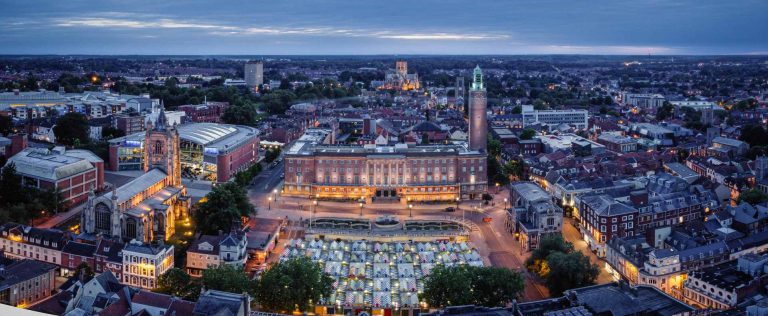Norwich reboilering heat pump feasibility study
Norwich City Council
Services
- Building Surveying
- Carbon Reduction
- Energy Consultancy
- Feasibility

- Name
PAUL COCKADAY
DIRECTOR OF CONSULTINGBA (Hons), MA, MSc- Telephone
- 07595 551835
- Paul.Cockaday@norseenergy.co.uk
- View Biography
Project Summary
Norse Consulting’s support through its Joint Venture with NCC resulted in NCC securing Low Carbon Skills Funding from Salix to carry out a feasibility study to determine whether heat pumps could be incorporated into the gas boiler replacement scheme.
The brief for Norse Consulting to deliver the project included:
. Survey the premises and identify potential locations for the air-source heat pumps regarding the location of the existing plant, noise attenuation, the listing building status of City Hall, the status of the existing electricity supply and any structural constraints.
. Identify the fossil fuel and carbon savings.
. Installation costs.
. Consider other relevant technologies that could be applicable.
. Consideration of other relevant technologies.
. A feasibility report detailing the outcomes of the issues considered above.
. Prepare a compliant PSDS Application Form to enable a Grant Application to be made to Salix.
Project Overview
Norwich City Council (NCC) had approved a scheme to replace 2 life-expired gas fired space heating boilers with 4 new high efficiency gas fired boilers at Norwich City Hall.
Provision would be made in the new installation to connect an element of renewable technology to supplement the new gas boilers in the form of an Air Source Heat Pump (ASHP) system. NCC had set a target to reduce their operational carbon emissions to Net Zero by 2030, and the installation of an air source heat pump in conjunction with modern high-efficiency gas condensing boilers at Norwich City Hall would contribute towards this.
Project Impact
A site survey was carried out to identify a suitable location for an air source heat pump, and three locations were initially considered and assessed in terms of their overall suitability:-
1. NORTH COURTYARD
The preferred and possibly most viable location, in terms of the space available and the close proximity to the plant room and the main electrical supply.
Subject to design, the following constraints were identified and would require further investigation:
· Cranage of the unit(s) into position within the courtyard.
· Structural support and underground services within the courtyard.
· Sufficient free air around the unit(s).
· Plant noise and attenuation.
· Planning Permission and Listed Building Consent.
Initial investigations and research indicated that the proposed installation within the courtyard should be feasible.
2. ROOFTOP
The rooftop as an alternative location for the air source heat pump(s). There were some concerns with regard to the structural support required, and the amount of strengthening that might be necessary to adequately support the unit(s).
As Norwich City Hall is a Grade 2* listed building of national significance any plant installed on the roof would need to be kept below parapet level to avoid detracting from the appearance of the building.
3. FORMER CAR PARK AND GRASSED AREA
A former car park at the rear of the building and a grassed area along St Giles Street were also considered. These locations are some distance from the main plant room and there would be significant difficulty in routing heating pipes to the plant room.
Locating plant on the grassed area would likely receive resistance and planning objections being detrimental to the street scene and setting of the main building.
The car park location could be considered further although there are still likely to be some difficulties.
HEAT PUMP SPECIFICATION OPTIONS
There were two types of air source heat pump that were considered: –
1. LOCHINVAR AMICUS LT AIR SOURCE HEAT PUMP
A Lochinvar Amicus LT low temperature air source heat pump would contribute circa 50% of the heating load.
2. MITSUBISHI ECODAN CAHV MONOBLOC AIR SOURCE HEAT PUMPS
Six Mitsubishi Ecodan CAHV-P500YB-HPB monobloc air source heat pumps each having significantly less output. The Mitsubishi heat pumps are much smaller and would therefore be far easier to install, although the combined heat output would be less than for the largest Lochinvar Amicus air source heat pump. This option would contribute circa 25% of the heating load.
SELECTION AND LOCATION
For the purpose of maximising the potential energy and carbon savings and funding from the Public Sector Decarbonisation Scheme (PSDS) a Lochinvar Amicus Air Source Heat Pump was chosen. Given that the preferred location was the North Courtyard the opportunity was taken to include an upgrade to the glazing in that location. All together the Council made a successful PSDS application securing £477,500 of capital to deliver the project together with some additional funding for a LED replacement scheme and ongoing management of its wider carbon management programme.